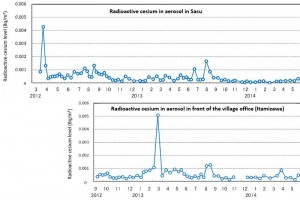Rubble removal at nuclear power plant spread cesium to Iitate’s aerosol?
Reported by Yukiko Dokiya
On July 15 and 16, 2014, Asahi Shimbun reported the news including the following new findings:
- In autumn of 2013, it was a very discouraging news for the farmers in Fukushima that Cesium levels in the rice crops harvested in Minami Soma exceeded the safety standard of 100 Bq/kg. Then almost one year passed, Asahi Shimbun revealed that the rice contamination in Minami Soma was very likely caused by the rubble removal work at Fukushima Daiichi nuclear power plant conducted in July, 2013.
- The Ministry of Agriculture, Forestry and Fisheries noticed this problem in March of 2014 and called on TEPCO to take preventive measures in its debris-removal work. TEPCO has not told the public about the ministry’s findings. Ministry officials said they planned to disclose the findings after confirming the cause of the rice crop contamination. The mayor of Minami Soma said. “We protest (TEPCO’s) irresponsible clearing of rubble that raises concern among farmers and citizens, and “We demand an explanation.”
- Professor A. Koizumi of Graduate School of Medicine, Kyoto University and four other scientists measured the Cesium concentration in atmospheric dusts and reported that 20-30 times higher level of cesium was detected at Minami Soma city and 6 times at Soma city. With the wind’s speed and direction at that time, as well as size of the collected particles, they concluded that the radioactive cesium of the rice in Minami Soma resulted from the rubble removal work at Fukushima Daiichi plant on Aug. 19, 2013. In March of 2014, the scientists presented their findings to the Ministry of the Environment.
- Tokyo Electric Power Co. (TEPCO) plans to clear the debris from the Fukushima Daiichi nuclear plant despite strong indications that earlier removal work contaminated rice paddies far from the area of the damaged plant.
Resurrection of Fukushima has been continuously monitoring radioactivity in atmospheric dust (aerosol) in Sasu and in front of the village office (Itamizazawa) in Iitate village since 2012, as a collaborative work with the National Institute for Environmental Studies. The monitoring data at both points showed that radioactive cesium level of aerosol in the week of August 19 was 3- 4 times higher than the other weeks in 2013 (see attached graphs). Since similar level of increase was identified at both monitoring points, we recognized at that time that something but not localized (e.g. within Iitate village) might happen (c.f. the graph of the village office has the highest peak in April of 2013 due to the surface removal of the concrete pavement near the office building during the decontamination work, while the graph of Sasu shows no peak at that time.)
By the article of the Asahi Shimbun, we realized that the increase of radioactive cesium level in the aerosol of Iitate in August of 2013 was coincident with the rubble removal work in the nuclear power plant. In the article, a contamination map is attached, which shows the locations of air sampling with the results, and the locations of cultivated rice detected radioactive cesium higher than the standard level in Minami Soma. Reading the article (see the link: http://www.asahi.com/articles/photo/AS20140715005861.html), we recognized that Iitate being located near the western edge of the wide radioactive plume calculated by SPEEDI (System for Prediction of Environmental Emergency Dose Information), thus, has received some radioactive Cesium in aerosol samples. TEPCO appeared to have apologized to the Mayor of Minami Soma, however, another rubble removal is also reported to be scheduled. We hope that detailed information of soil contamination and hot spots will also be disclosed geographically in the same manner.
Currently, decontamination work is ongoing for residential houses and farm lands, and the farmers are making desperate efforts to restart cultivation. Under these circumstances, additional contamination is completely unacceptable. Furthermore, it is difficult to identify the contaminant source, unless polluters spontaneously disclose the information. We strongly request TEPCO and the government to immediately disclose all the precise data on the rubble removal.
(Please click the graph below to view it at a larger size)
